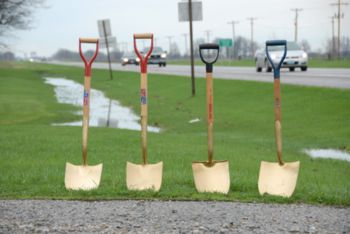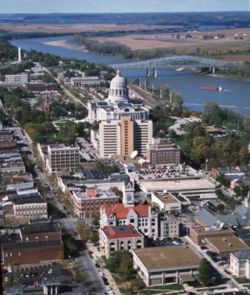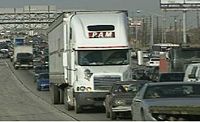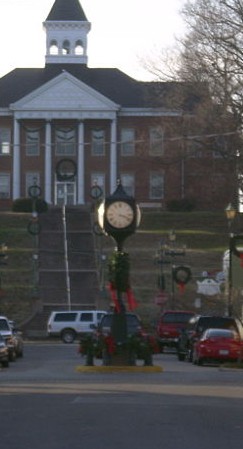121.5 Asset Management: Difference between revisions
m Updated links to MPO info |
m →121.5.16 Functional Classification: added link |
||
| Line 227: | Line 227: | ||
===121.5.16 Functional Classification=== | ===121.5.16 Functional Classification=== | ||
The Functional Classification (FC) system groups streets and highways according to the character of service they are intended to provide. The FC can be found in [http://tmshome TMS] in the SOS Detail Browser. For purposes of this process, the principal arterial functional classification is further divided into design types: interstates, freeways, expressways and other principal arterials. | The [http://www.modot.org/newsandinfo/functionalclassificationmaps/index.htm Functional Classification] (FC) system groups streets and highways according to the character of service they are intended to provide. The FC can be found in [http://tmshome TMS] in the SOS Detail Browser. For purposes of this process, the principal arterial functional classification is further divided into design types: interstates, freeways, expressways and other principal arterials. | ||
====<center>''Table 121.5.17 Scoring (as a percentage of TPV) of Functional Classification''</center>==== | ====<center>''Table 121.5.17 Scoring (as a percentage of TPV) of Functional Classification''</center>==== | ||
| Line 255: | Line 255: | ||
| align="center"|-||Other|| align="center"|0% | | align="center"|-||Other|| align="center"|0% | ||
|} | |} | ||
===121.5.17 Functional Obsolescence of Bridge=== | ===121.5.17 Functional Obsolescence of Bridge=== | ||
Revision as of 10:38, 12 August 2013

Total Point Value (TPV) represents the maximum point value for a given factor. The Total Points awarded for the factor cannot be negative and cannot be more than the TPV. These limits are implied in the formulas that follow even if not expressly written.
121.5.1 Crash Rate
The Crash Rate (CR) can either be segment-based (rate per Hundred Million Vehicle Miles traveled) or intersection-based (rate per Million Entering Vehicles). The Statewide Crash Rate (SWCR) is the average crash rate for similar routes/intersections throughout the state. The score for the crash rate is based on the ratio of the project segment’s Crash Rate (CR) over the Statewide Crash Rate (SWCR).
| Additional Information |
| Segment Crash Rate and Intersection Crash Rate Calculations |
Data: CR = Crash Rate of roadway segment or intersection
SWCR = Statewide Crash Rate of similar segments or intersections
Formula:
- Total Points = TPV × ( CR / SWCR – 1 )
| Intermodal Connections, Port Access |
| Report 2002 |
| Pavement Smoothness and Fuel Efficiency |
| Summary 2006 |
| Summary 2008 |
| Report Report 2006 |
| Pavement Smoothness Measures |
| Report 2006 |
| See also: Innovation Library |
121.5.2 Crash Severity
Crash Severity is based upon the number and severity of crashes and expressed through the Severity Ratio. The Equivalent Property Damage Only (EPDO) calculation shall be based upon the following factors:
Data: EPDO = Equivalent Property Damage Only Crashes
TNC = Total Number of Crashes
SR = Severity Ratio
Formula:
EPDO = 9 × Fatal Crashes + 6 × Disabling Injury Crashes + 2 × Minor Injury Crashes + 1.0 × Property Damage Only Crashes
SR = EPDO / TNC
Total Points = TPV × (SR – 1)
The Severity Number calculation is similar to the EPDO calculation, but focuses only on severe crashes.
The Severity Number Formula:
- Severity Number = 9 × Fatal Crashes + 6 × Disabling Injury Crashes
121.5.3 Annual Average Daily Traffic (AADT)
See Daily Usage

121.5.4 Bridge Condition
Every bridge has three condition ratings: one for the bridge deck, one for the substructure and one for the superstructure. The deck bridge condition rates the overall condition of the bridge deck on a scale of 1 through 9, with 1 being the worst condition and 9 being the best condition. The substructure bridge condition rates the physical condition of piers, abutments, piles, fenders, footings and other components using the same scale. The superstructure bridge condition rates the condition of structural members, also using the same 1 through 9 scale.
Bridge Condition is scored using a composite of the worst bridge condition rating of the three types (deck, substructure or superstructure) and an average of the remaining two bridge condition ratings.
Data: BCD = Deck Condition Rating
BCSUB = Substructure Condition Rating
BCSUPER = Superstructure Condition Rating
Formula:
BCLOW = Minimum ( BCD, BCSUB, BCSUPER ) { Worst condition rating }
BCAVG = ( BCD + BCSUB + BCSUPER – BCLOW ) ÷ 2 { Average of the two BEST ratings }
- 1st Points = 0 ≤ ( 6 – BCLOW ) ÷ 3 × ½ × TPV ≤ ½ × TPV
- 2nd Points = 0 ≤ (6 – BCAVG ) ÷ 3 × ½ × TPV ≤ ½ × TPV
Total Points = 1st Points + 2nd Points
Examples:
Bridge 1: Regional and Emerging Needs Project
Deck Condition = 3, Superstructure Condition = 4, Substructure Condition = 5
- BCLOW = BCD = 3
- BCAVG = ½ × ( BCSUB + BCSUPER ) = [(5+4)/2] = 4.5
- 1st Points = ( 6 – 3 ) / 3 × ½ × TPV = ½ × TPV
- 2nd Points = ( 6 – 4.5 ) / 3 × ½ × TPV = ¼ × TPV
- PV = 40 (for example)
Total Points = ½ × 40 + ¼ × 40 = 30
121.5.5 Bridge Width
See Substandard Bridge Features.
121.5.6 Compliance with Regional or Local Land-Use Plan
Regional Planning Commissions (RPCs) and Metropolitan Planning Organizations (MPOs) will be responsible for identifying relevant land-use plans (comprehensive or master plans) for a project area, and will also be responsible for determining whether or not the project complies with the plan(s). Projects in areas that do not have an adopted land use plan do not score points for this factor.
In the event that multiple land-use plans are applicable to a project, the project must be in compliance with the plan(s) that cover the majority of the project area.
Scoring: Does the project comply with regional or local land use plans? If “yes,” then award TPV. If “no,” then award zero points.
121.5.7 Compliance with Regional or Local Transportation Plans

Regional Planning Commissions (RPCs) and Metropolitan Planning Organizations (MPOs) will be responsible for determining whether a functional transportation need is identified in their long-range transportation plan and whether addressing that need is in compliance with the plan.
In Metropolitan Planning Organization areas, no project utilizing Federal funds may be programmed unless the project complies with the MPO long-range transportation plan. This requirement is mandated by Federal law and applies to all types of projects. It is also assumed that, in general, MoDOT will not be programming projects that are not in compliance with the RPC long-range transportation plans.
Cities and counties also address transportation in their own comprehensive plans. In addition, all jurisdictions may compose a plan for a specific corridor.
Table 121.5.7 Scoring (as a percentage of TPV) of Compliance with Regional of Local Transportation Plan
| Select only one of the following plans that identify the needs | |
|---|---|
| MPO Long-Range Transportation Plan | 100% |
| RPC Long-Range Transportation Plan | 80% |
| City or County Comprehensive Plan | 60% |
| Corridor Plan | 60% |

121.5.8 Connectivity
Connectivity between activity centers is important on the local and regional scale. Activity centers are sub-regional or sub-community districts that generate a concentration of trips such as schools and colleges, shopping centers, government complexes, apartment complexes and hospitals. The scale of activity centers is dependent on the size of the community. Activity centers relevant to a project or need should be identified in a collaborative process involving Regional Planning Commission or Metropolitan Planning Organization and local officials. Connectivity between activity centers for statewide needs may be defined as the linkage between cities and regions.
For this process, connectivity between cities and regions focuses on linking urban centers throughout Missouri. The U.S. Census Bureau has defined cities as densely populated areas (Urban Clusters and Urbanized Areas). These urban areas are typically regional centers for trade, education, healthcare and government. For purposes of prioritization, connectivity will applies to improved connections between Urban Clusters (over 5,000 population) and/or Urbanized Areas (over 50,000 population).
Scoring: For projects: Does the project improve a connection between activity centers or between cities and regions? If “yes,” award the TPV. If “no,” award zero points.
For needs: Does the need include a problem with sufficient connectivity between activity centers or between cities and regions? If “yes,” award the TPV. If “no,” award zero points.
121.5.9 Daily Usage (DU)
Defined as the total volume of traffic passing a point or segment of a highway for one year divided by the number of days in the year and number of through lanes. The AADT and the number of through lanes can be found in TMS in the SOS Detail Browser.
Data:
NL = Number of through (driving) lanes
AADT = Annual Average Daily Traffic
DU = Daily Usage
Formula:
DU = AADT/NL
Total Points = ( DU / 17,500 )2 × TPV
121.5.10 Detour Length
See User Costs.
121.5.11 District Factors/Flexible Points
MoDOT districts, in collaboration with MoDOT’s planning partners, designate additional factors to be used to evaluate each investment goal. Factors from other prioritization processes may be used as a district factor. Districts may also increase the point value of factors used in the core process. The use of points for other factors should be documented as an addendum to this article.
121.5.12 Elimination of Bike/Pedestrian Barriers
The elimination of bike and pedestrian barriers is necessary to promote an integrated walking and biking system in Missouri communities. This prioritization factor focuses on areas where a bike and/or pedestrian need is likely. Items 3 and 4 should be used only when items 1 or 2 do not apply.
Table 121.5.12 Scoring (as a percentage of TPV) of Elimination of Bike/Pedestrian Barriers
| Scoring: The project scores are the sum of the points for each of the following | |
|---|---|
| 1. Project improves a bike connection between complimentary land uses (e.g. between commercial, institutional and residential uses) or between complimentary land uses and transit stops. | 40% |
| 2. Project improves a pedestrian connection between complimentary land uses (e.g. between commercial, institutional and residential uses) or between complimentary land uses and transit stops. | 60% |
| 3. Project brings an existing pedestrian connection into compliance with the Americans with Disabilities Act (ADA). | 20% |
| 4. Project provides bike and/or pedestrian accommodations not applicable to any of the above situations. | 20% |
| 5. Project provides no bike or pedestrian accommodations | 0% |
| Maximum Possible Total Points | 100% |
121.5.13 Environmental Index
As part of MoDOT’s investment goal to protect the natural environment, the Federal environmental review process is used as an indicator for environmental impact. This factor specifically favors projects where no environmental mitigation is required.
Scoring: Does the project require environmental mitigation? If “yes,” award zero points. If “no,” award TPV.
121.5.14 Exceptional Bridge
An exceptional bridge is one that has a deck or superstructure rating of 4 or less; or a substructure rating of 5 or less and one of the following items: permanent shoring, requires extensive or habitual maintenance, or requires maintenance beyond the capabilities of the MoDOT district’s repair crews.
Scoring: Does the project rehabilitate or replace an exceptional bridge? If “yes,” award TPV. If “no,” award zero points.
121.5.15 Freight Bottlenecks

MoDOT districts in consultation with RPCs and MPOs identify freight bottlenecks. Examples of freight bottlenecks include load posted bridges, inadequate vertical or horizontal clearances, or gaps in the freight movement system.
Scoring: Does this project eliminate one or more freight bottlenecks? If “yes,” award TPV. If “no,” award zero points.
121.5.16 Functional Classification
The Functional Classification (FC) system groups streets and highways according to the character of service they are intended to provide. The FC can be found in TMS in the SOS Detail Browser. For purposes of this process, the principal arterial functional classification is further divided into design types: interstates, freeways, expressways and other principal arterials.
Table 121.5.17 Scoring (as a percentage of TPV) of Functional Classification
| Functional Class | % TPV | |
|---|---|---|
| Principal Arterials | Interstate | 100% |
| Freeway | 100% | |
| Expressway | 100% | |
| Other | 100% | |
| - | Major Collector | 50% |
| - | Minor Arterial | 40% |
| - | Minor Collector | 40% |
| - | Collector | 20% |
| - | Local | 20% |
| - | Other | 0% |
121.5.17 Functional Obsolescence of Bridge
See Substandard Bridge Features.
121.5.18 Intermodal Freight Connectivity
| Intermodal Connections, Port Access |
| Report, 2002 |
| Columbia Terminal Railroad Feasibility Analysis |
| Report, 2009 |
| See also: Innovation Library |
Intermodal connectivity includes improving connections between transportation modes for freight. Intermodal freight facilities are identified by MoDOT districts, RPCs and MPOs and include water ports, airports, rail terminals and truck terminals. Emphasis should be placed on connectivity between facilities where freight changes modes.
Scoring: Does the PROJECT improve connectivity with an intermodal freight facility OR is this a NEED to provide a better connection to an intermodal freight facility? If “yes,” award TPV. If “no,” award zero points.
121.5.19 International Roughness Index (IRI)
See Pavement Smoothness.
121.5.20 Level of Economic Distress
The level of economic distress is measured through poverty rates and unemployment levels within the project area or corridor. The poverty rate will be compared with statewide and regional or district averages. For purposes of prioritization, an unemployment rate of 10% or more is considered high.
Table 121.5.20 Scoring for Level of Economic Distress
| Scoring: The project scores are the sum of the points for each of the following | |
|---|---|
| The percentage of persons below the poverty level in the project area is higher than the statewide average. | 30% |
| The percentage of persons below the poverty level in the project area is high than the RPC level. | 40% |
| Unemployment is greater than 10% | 30% |
| Unemployment is between 5% and 10% | 15% |
| Unemployment is less than 5% | 0% |
| Maximum Possible Total Points | 100% |
121.5.21 Level of Service
Level of Service (LOS) is current year LOS and is a measure describing operational conditions within a traffic stream. Six LOS are defined for each type of facility. Letters designate each level, from A to F, with LOS A representing best operating conditions and Level of Service F the worst. For each process, the project is assigned a number of points based on the level of service currently experienced in the corridor. The worse the level of service is, the higher the score is.
Scoring (as a percentage of TPV):
- LOS A, 0%
- LOS B, 20%
- LOS C, 40%
- LOS D, 60%
- LOS E, 80%
- LOS F, 100%
121.5.22 Load Rating
Load Rating should be scored based on the load capacity of the structure. If a major structure is load-posted for legal loads, then it should always have the highest score. If no load posting exists, then the inventory rating can be used to come up with a score of the load capacity of the structure in relation to the current design loading. The inventory rating is a representation of the load capacity of a structure in relation to current design loads.
Scoring:
a. If bridge is posted for Legal Loads then the score = 100% TPV
b. If Bridge is not posted for Legal Loads, then determine the score as follows:
- Score = [ 1- ( inventory rating ) ÷ 36 ] × TPV
121.5.23 Metropolitan (MPO) Long-range Transportation Plan
See Compliance with Regional or Local Transportation Plan
121.5.24 Pavement Condition
The Pavement Condition score includes distresses (cracking, rutting, spalling, etc.) that are present in the pavement. The range for the condition score is 0 to 20 with 20 indicating pavement in perfect condition. The table shows the pavement condition score and the classification of the pavement condition (“good”, “fair”, “poor”, etc.) The relationship between pavement condition and the prioritization score is shown in the last column of the table.
Table 121.5.24 Pavement Condition
| Condition Classification | Condition Score | Score (% TPV) | |
|---|---|---|---|
| NHS | Non-NHS | ||
| Very Good | 18.9 – 20 | 18.9 – 20 | 0% |
| Good | 17.8 – 18.8 | 17.7 – 18.8 | 25% |
| Fair | 16.4 – 17.7 | 15.9 – 17.6 | 50% |
| Poor | 15.3 – 16.3 | 14.3 – 15.8 | 75% |
| Very Poor | 0 – 15.2 | 0 – 14.2 | 100% |
| Pavement Smoothness and Fuel Efficiency |
| Summary 2006 |
| Summary 2008 |
| Report Report 2006 |
| Pavement Smoothness Measures |
| Report 2006 |
| See also: Innovation Library |
121.5.25 Pavement Smoothness
The International Roughness Index (IRI) measures smoothness. The IRI varies from approximately “0” to “300”, with “0” indicating a perfect roadway. The measurement for IRI used and how the ratings are scored in the prioritization process is shown in the table below.
Table 121.5.25 Pavement Smoothness
| Smoothness Rating | IRI | Score (% TPV) |
|---|---|---|
| Very Good | <60 | 0% |
| Good | 60 - 94 | 25% |
| Fair | 95 - 170 | 50% |
| Mediocre | 171 - 220 | 75% |
| Poor | >220 | 100% |
121.5.26 Safety Concern
MoDOT receives input from the public and officials from other government agencies that includes numerous safety concerns. Some of these concerns are backed and some are not by MoDOT’s safety data. Both types of safety concerns have a role in this prioritization process.
Safety concerns should be identified through documented trends in MoDOT customer service reports, public input from the planning process, and input from local and regional planning partners.
Scoring: Does the PROJECT address a documented safety concern OR is the NEED a documented safety concern? If “yes,” award TPV. If “no,” award zero points.
121.5.27 Safety Enhancements
Safety Enhancements include the need for items such as guardrail, guard cable, clear zones, etc.
Scoring: Does the PROJECT address a need for safety enhancements? If “yes,” award TPV. If “no,” award zero points.
121.5.28 Safety Index
The safety index is made up of the following components:
1. Accident Index (10%) – compares the total accident rate to the statewide rate
2. Severity Index (60%) - compares the rate of injury and fatal crashes to statewide rates
3. High Accident Index (15%) - assigns a value based on locations that show up on the annual high accident listing
4. Wet / Dry Index (15%) – assigns a value based on locations that show up on the annual wet/dry listing
The Safety Index (SI) can be found in TMS in the SOS Detail Browser. The values are based on Traffic Information Segments (typically major intersection to major intersection). The value of the SI will be a number between 1 and 5; with 5 being a safety rating of “Very Good” and 1 being a safety rating of “Very Poor”. If the project encompasses more than one Traffic Information Segment, then the SI shall be a weighted average based on the length of each segment.
Data: SI = Safety Index
Formula: Total Points = (5 – SI ) × ¼ × TPV
121.5.29 Strategic Economic Corridor
Strategic Economic Corridors are corridors that connect regional economic centers in Missouri and adjacent states. The regional economic centers selected for this process are based on information from the Missouri Department of Economic Development and the Office of Social and Economic Data Analysis at the University of Missouri. All interstates are considered strategic economic corridors. A list of regional economic centers and examples of strategic economic corridors follows:


Table 121.5.29.1 Regional Economic Centers
| Missouri | Out of State |
|---|---|
| Branson | Omaha, NE |
| Cape Girardeau | Fayetteville, AR |
| Chillicothe-Brookfield | Jonesboro, AR |
| Columbia | Paducah, KY |
| Farmington | Memphis, TN |
| Fort Leonard Wood | Springfield, IL |
| Hannibal | Quincy, IL |
| Jefferson City | Ottumwa, IA |
| Joplin | Des Moines, IA |
| Kansas City | Pittsburg, KS |
| Kirksville | Wichita, KS |
| Lake of the Ozarks | Tulsa, OK |
| Poplar Bluff | - |
| Rolla | - |
| Sedalia | - |
| Sikeston | - |
| Springfield | - |
| St. Joseph | - |
| St. Louis (including St. Charles) | - |
| Warrensburg-Knob Knoster | - |
| West Plains | - |
Table 121.5.29.2 Example Corridors
| I-70 | Topeka - Kansas City – Columbia – St. Louis |
| I-44 | Tulsa - Joplin – Springfield – Ft. Wood – Rolla –St. Louis |
| I-35 | Kansas City – Des Moines |
| I-55 | St. Louis – Cape Girardeau – Sikeston – Memphis |
| I-29 | Kansas City – St. Joseph – Omaha |
| U.S. 60/360 | Springfield – Poplar Bluff – Sikeston – Paducah |
| U.S. 36 | Hannibal – Chillicothe – St. Joseph |
| U.S. 71 | Maryville – St. Joseph – Kansas City – Joplin – Fayetteville |
| U.S. 60/Route 37 | Springfield – Fayetteville |
| U.S. 54 | Wichita – Lake of the Ozarks – Jefferson City |
| Route 5 | Springfield – Lake of the Ozarks – Jefferson City |
| Route 13 | Kansas City – Springfield |
| U.S. 63 | Ottumwa – Kirksville - Columbia – Jefferson City – Rolla – West Plains |
| U.S. 65 | Des Moines – Chillicothe – Sedalia – Springfield – Branson |
| U.S. 50 | Kansas City – Warrensburg/Knob Noster – Sedalia – Jefferson City – St. Louis |
| U.S. 67 | St. Louis – Farmington – Poplar Bluff |
| Route 171/U.S. 400 | Joplin – Pittsburg -- Wichita |
| All other interstates | Various |
Scoring: Does the project improve a strategic economic corridor? If “yes,” award TPV. If “no,”award zero points.
121.5.30 Substandard Bridge Features
Bridges that do not meet the standards of MoDOT’s long-range transportation plan are considered obsolete.
Scoring: Does the PROJECT address substandard bridge features OR are substandard bridge features part of this NEED? If “yes,” award TPV. If “no,” award zero points.
121.5.31 Substandard Roadway Features
Substandard roadway features include aspects such as the lane width or shoulder width, as defined in MoDOT’s long-range transportation plan.
Scoring: Does the PROJECT address substandard roadway features OR are substandard roadway features part of this NEED? If “yes,” award TPV. If “no,” award zero points.
121.5.32 Supports Regional Economic Development Plans
The potential to promote economic development is determined by compliance with the regional economic development plan. Some RPCs have prepared a Comprehensive Economic Development Strategy (CEDS). MPOs have an economic development component in their LRTPs. RPCs and MPOs must use these as their regional economic development plans. Where there is no current CEDS, the RPC or MPO is tasked with identifying the economic development plan for their area. The RPC or MPO may use regional and community economic development plans written by the local Chambers, cities and counties, or economic partnerships. RPCs and MPOs will be responsible for determining if a project is in compliance with the regional economic development plan, or if the need is identified in the regional economic development plan.
Scoring: Does this project or need comply with a Regional Economic Development Plan? If “yes,” award TPV. If “no,” award zero points.
121.5.33 System Efficiency
System efficiency promotes improved traffic flow without adding lanes to a roadway. Some examples of system efficiency techniques are access management, intelligent transportation systems, and transportation demand management.
Scoring (as a percentage of TPV):
- Project does not include system efficiency elements: 0%
- Project includes elements of both roadway expansion and system efficiency: 50%
- Project improves system efficiency without roadway expansion: 100%
121.5.34 Truck Usage
Truck usage is used to indicate the impact of heavy vehicles on the state system and the movement of freight on the state system.
Data:
VTR = Estimated Volume of Trucks
NL = Number of through (driving) lanes
TU = Truck Usage
Formula:
- TU = VTR/NL
Total Points = (5 × TU )1/2 ÷ 100 × TPV
121.5.35 Truck Volume
Truck volume is used to indicate movement of freight on the state roadway system. The estimated volume of trucks is found in TMS as TOTAL COMMERCIAL VOLUME.
Data:
TV = Total Commercial Volume
Formula:
- Total Points = (2.5 × TU )1/2 ÷ 100 × TPV
121.5.36 User Cost Index (Detour Length)
User cost, for purposes of the prioritization process, currently only considers detour length. The detour length is weighted by the amount of traffic to give the prioritization score.
Data:
DL = Detour Length (miles)
AADT = Annual Average Daily Traffic
UCI = User Cost Index
Formula:
- UCI = DL × AADT
Total Points = UCI ÷ 1,000,000 × TPV
121.5.37 Vehicle Ownership
The intent of this factor is to be a proxy for needs for other modes of transportation. While vehicle ownership does not always mean there is a need for other modes of transportation, a general correlation can be made. This data is based on 2000 Census data, and is scored on percentage of households WITHOUT a vehicle, compiled by county. The percentages ranged from 3.6 to 25.2%.
Data:
PW = Percentage of households WITHOUT a vehicle
Formula:
- Total Points = (PW – 4% ) ÷ 4.9% × TPV
